Illustration plates (lithographs) from 'The Book of Wonderful Characters: Memoirs and Anecdotes of Remarkable and Eccentric Persons in all Ages and Countries, Chiefly from the Text of Henry Wilson and James Caulfield', 1869. [See Part I]
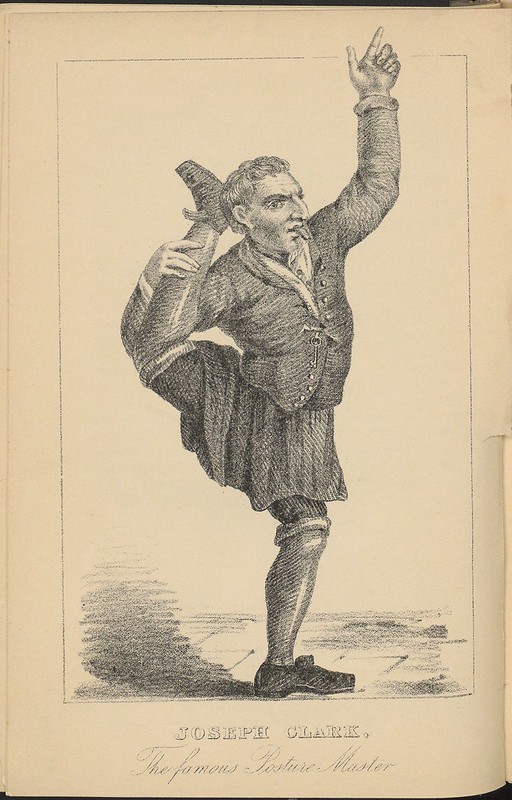
Joseph Clark, The Famous Posture-Master
"He frequently diverted himself with the tailors, by sending for one of them to take measure of him, and would so contrive it as to have a most immoderate rising in one of the shoulders: when the clothes were brought home, and tried upon him, the deformity was removed into the other shoulder; upon which the tailor asked pardon for his mistake, and altered the garment as expeditiously as possible: but, upon a third trial, he found him perfectly free from blemish about the shoulders, though an unfortunate lump appeared upon his back. In short, this wandering tumour puzzled all the workmen about town, who found it impossible to accommodate so changeable a customer."

Floram Marchand - The Water-Spouter
In the summer of 1650, a Frenchman named Floram Marchand was brought over from Tours to London who professed to be able to "turn water into wine, and at his vomit render not only the tincture, but the strength and smell of several wines, and several waters. [..]
To conclude all, and to show you what a man of might he is, he has an instrument made of tin, which he puts between his lips and teeth this instrument has three several pipes, out of which, his arms a-kimbo, and putting forth himself, he will throw forth water from him in three pipes, the distance of four or five yards. This is all clear water, which he does with so much port and such a flowing grace, as if it were his masterpiece."
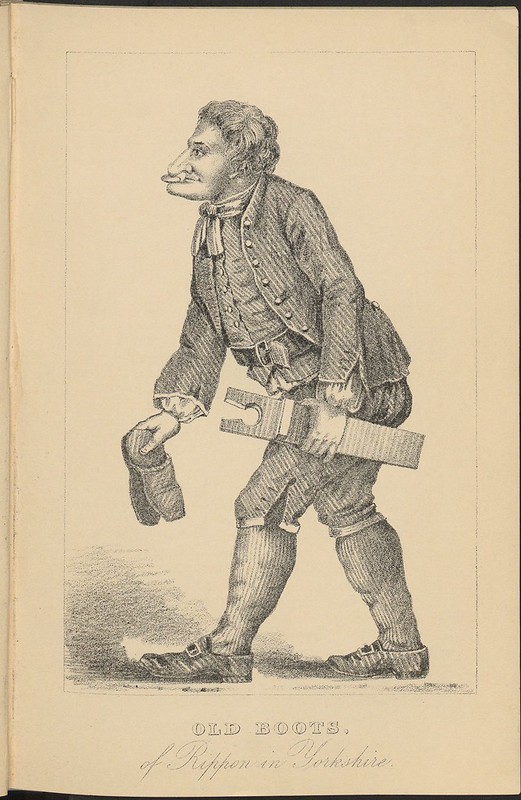
Old Boots of Rippon in Yorkshire
"[Old Boots was] born about the year 1692, and, for some length of time, filled the important office of boot-cleaner at an inn in Ripon in Yorkshire. He was a perfect 'lusus naturæ',^ dame nature forming him in one of her freakish humours. He was blessed with a plentitude of nose and chin, and so tenderly endearing were they, that they used to embrace each other; and by habit, he could hold a piece of money between them. [..]
[T]he urbanity of his manners was always pleasing to the company, who frequently gave him money, on condition that he would hold it between his nose and chin; which request he always complied with, and bore off the treasure with great satisfaction. He was one of those fortunate beings who could daily accomplish that which thousands of persons are ineffectually striving all their lives to attain - 'he could make ends meet!' He died in 1762, at the age of seventy."
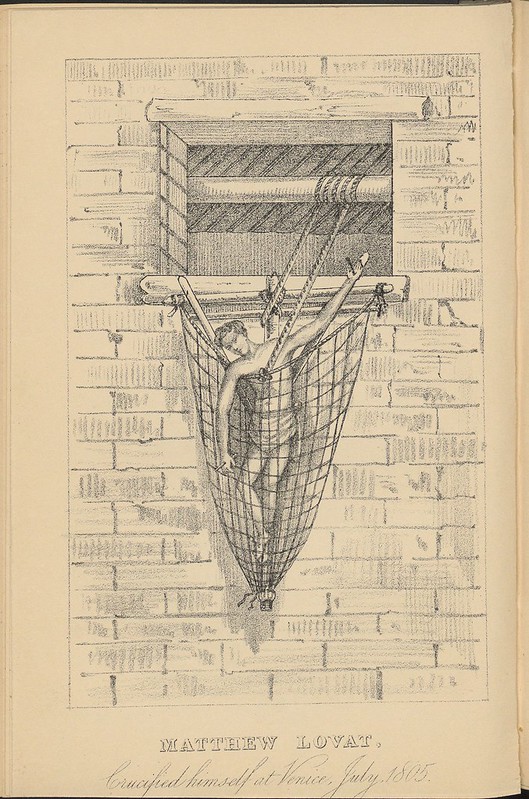
Matthew Lovat, crucified himself at Venice, July, 1805
"Having become a shoemaker by necessity, he never succeeded either as a neat or as a quick workman; the ordinary fate of those who are employed contrary to their inclinations. [..]
As his age increased, he became subject in the spring to the giddiness in his head, and eruptions of a leprous appearance showed themselves on his face and hands. [..] His life was regular and uniform; his habits were simple, and comfortable to his rank in society; nothing, in short, distinguished him but an extreme degree of devotion. He spoke on no other subject than the affairs of the church. [..]
[H]aving shut himself up in his chamber, and making use of one of the tools belonging to his trade, he performed upon himself the most complete general amuptation, and threw the parts which he had deprived his person from his window in to the street. [..] [I]s it not reasonable to think, considering the known character of the man that his timid conscience, taking the alarm at some little stirrings of the flesh against the spirit, had carried him to the resolution of freeing himself at once and for ever of so formidable an enemy? [..]
[H]is old ideas of crucifixion laid hold of him again. He wrought a little every day in forming the instrument of his torture, and provided himself with the necessary articles of nails, ropes, bands and the crown of thorns &c. [Lovat managed to spear his side and nail himself to the cross]
These bloody operations being concluded, it was now necessary, in order to complete the execution of the whole plan he had conceived, that Matthew should exhibit himself upon the cross to the eyes of the public. [..] [The cross] with the poor fanatic upon it, darted out at the window, and remained suspended outside of the house by the ropes which where secured to the beam inside."
{Lovat was soon after cut down and sent to a hospital for a a few weeks of wound treatment and then on to a lunatic asylum where he died from pneumonia a month after his attempt at self-crucifixion}

Count Joseph Boruwlaski - The Celebrated Polish Dwarf
"A STRIKING proof, if any were wanted, that the modifications of human nature are dependent on circumstances which have hitherto eluded all investigation, is afforded by the celebrated dwarf, Boruwlaski. To soundness of understanding, quickness of apprehension, and solidity of judgment, Boruwlaski united that fascinating ease and elegance of deportment which can only be acquired by intercourse with the highest classes of polished society, an advantage which hs uncommonly diminutive size, during the whole course of his life, never failed to procure him."
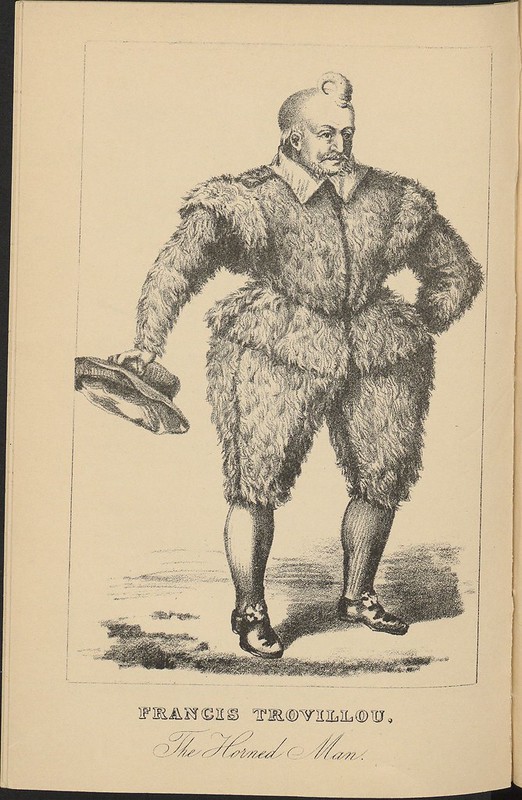
Francis Trovillou - The Horned Man
"In the year 1598 a horned man was exhibited for a show, at Paris, two months successively, and from thence carried to Orleans, where he died soon after. His name was Francis Trovillous, of whom Fabritius, in his Chiurgical Observations, gives the following description:- 'He was of middle stature, a full body, bald, except in the hinder part o' the head, which had a few hairs upon it; his temper was morose, and his demeanour was altogether rustic'.
He was born in a little village called Mezieres, and bred up In the woods amongst the charcoal men. About the seventh year of his age he began to have a swelling in his forehead, so that in the course of about ten years he had a horn there as big as a man's finger-end, which afterwards did admit of that growth and increase, that when he came to be thirty-five years old this horn had both the bigness and resemblance of a ram's horn."
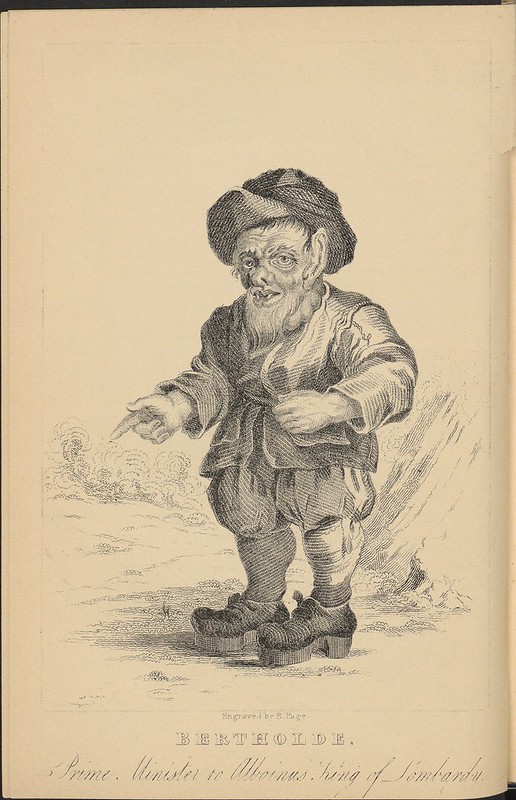
Bertholde - Prime Minister to Alboinus, King of Lombardy
"Bertholde had a large head, as round as a football, adorned with red hair very strait, and which had a great resemblance to the bristles of a hog; an extremeley short forehead, furrowed with wrinkles; two little blear eyes, edged round with a border of bright carnation, and over-shadowed by a pair of large eyebrows, which, upon occasion, might be made use of as brushes; a flat red nose, resembling an extinguisher; a wide mouth, from which proceeded two long crooked teeth, not unlike the tusks of a boar, an pointing to a pair of ears, like those which formerly belonged to Midas; a lip of a monstrous thickness, which hung down on a chin, that seemed to sink under the load of a beard, thick, strait, and bristly; a very short neck, which nature had adorned with a kind of necklace, formed of ten or twelve small wens.
The rest of the body was perfectly in keeping with the grotesque appearance of his visage; so that from head to foot, he was a kind of monster, who, by his deformity, and the hair with which he was covered, had a greater resemblance to a bear half licked into form, than a human being. [..] [H]e had a fund of wit, which sufficiently made him amends [.and.] the pleasure he gave to the other peasants was equal to the terror his figure caused in the little innocents. Bertholde diverted them on Sundays, and every festival, with the sallies of his wit: he instructed them by excellent sentences, which he uttered from time to time; so that, next to the priest and the lord of the manor, no person in the village was treated with greater respect. His poverty, contrary to custom, was not considered as a vice; and, what is very strange, it did not render him the object of aversion and contempt."
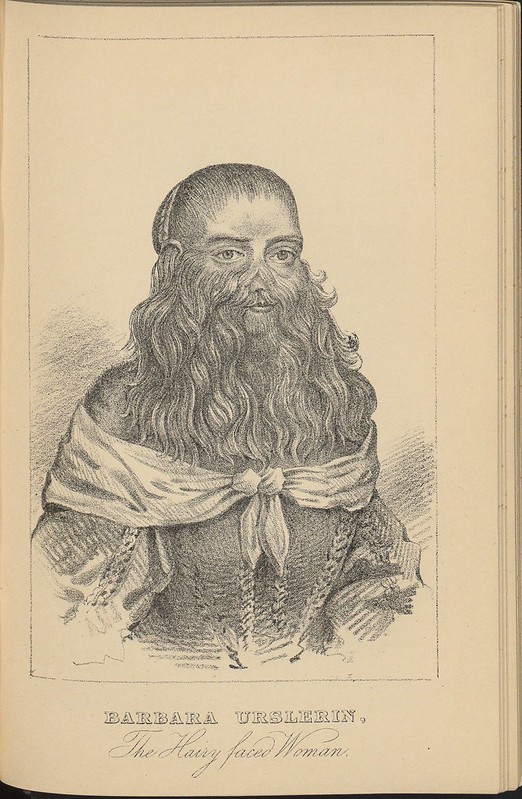
Barbara Urslerin - The Hairy Faced Woman
"This remarkable monstrosity was born at Augsburg, in High Germany, in the year 1629. Her face and hands are represented to have been hairy all over. Her aspect resembled that of a monkey. She had a very long and large spreading beard, the hair of which hung loose and flowing, like the hair of the head. She seems to have acquired some skill in playing on the organ and harpsichord. A certain Michael Vanbeck married this frightful creature, on purpose to carry her about for a show. When she died is uncertain, but she was still living in 1668, when a Mr. John Bulfinch records that he saw her in Ratcliffe Highway, and 'was satisfied she was a woman'."
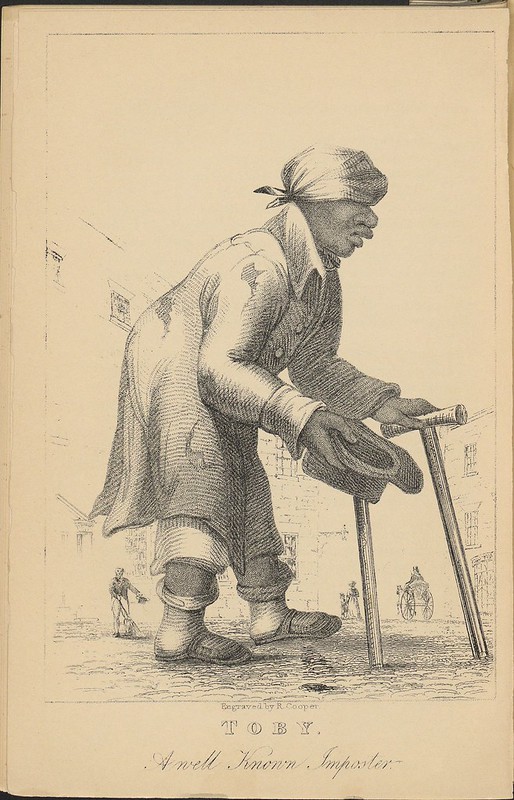
Toby - A Well Known Imposter
The BM goes on:
"With the accompanying letterpress transcribed in typescript, on a separate strip pasted to the verso: 'Toby. / This vile impostor, whose real name is unknown, was a negro, and, in the early part of the present century, frequented the streets of London, where successfully levied contributions on the credulity of the humane. Having lost all his toes, while on board a merchantman, he was rendered an object of compassion. During his perambulations he appeared almost double with age and infirmity, but when night came on, he threw off restrant, and walked upright to the beggars meeting, where there was not a more jovial member.' "
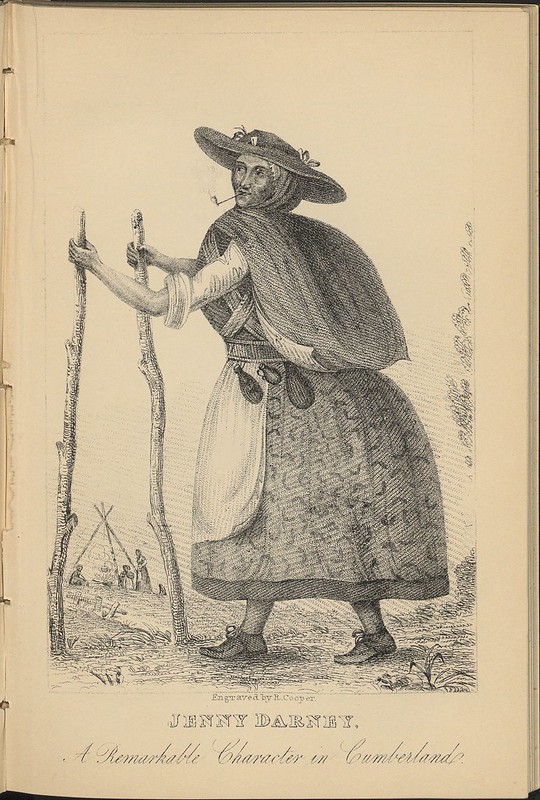
Jenny Darney - A Remarkable Character in Cumberland
"this remarkably inoffensive poor woman was well known in the southern part of the county of Cumberland. She was one of the many 'singles' whom Fate decreed should pass her probationary life secluded from the 'busy hum of men'. [..] The country people knew her by the name of Jenny Darney, from the manner, it is presumed, in which she used to mend her clothes. Her garb was entirely of her own manufacture. [..]
Her intellect seemed at certain times greatly deranged; but her actions harmless, and her language inoffensive. On that score, she was caressed by all the villagers, who supplied her with eatables, &c.; for money she utterly refused. She seemed a person of much shrewdness, and her understanding was above the common level: this was improved by a tolerable education.
She chose the spot where she lived, to pass the remainder of her days unknown to her friends, and in a great measure from distaste of a wicked world, to 'prepare herself', as she often in her quiet hours said, 'for a better.' At the time of her death, she was nearly 100 years old. Jenny Darney was another of the many proofs to what great age persons who live a retired and abstemious life, mostly attain."
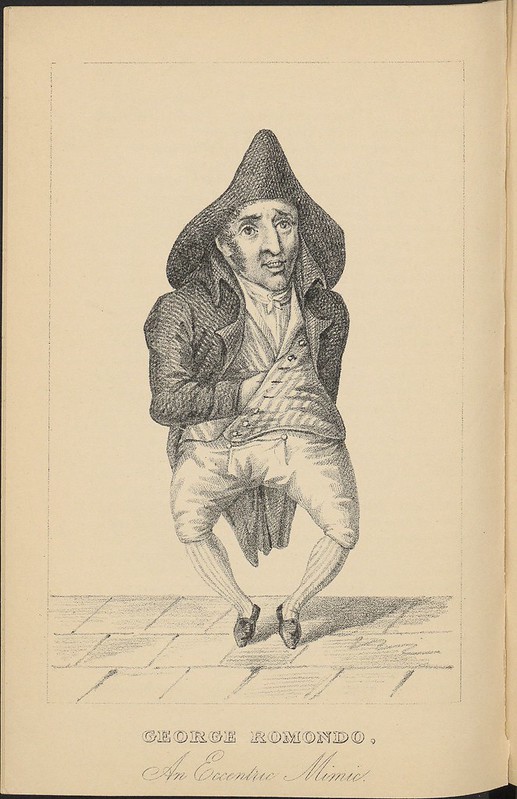
George Romondo - An Eccentric Mimic
"George Romondo, or Raymondo, attracted the notice of many by the singularity of his figure and dress. He was about three feet six inches in height. He had a large hat, cocked before and hanging down behind, like those commonly worn by coal-heavers. He was seldom seen except holding the skirts of his long coat behind him, lest they should be entangled with his feet.
He possessed a very acute ear, and such a voice that there was scarcely any kind of sound
which he was not capable of imitating. He not only gave the tones of the trumpet, the horn, the violin, the drum, the bag-pipe, and other instruments, but he modulated his powers to the braying of asses, the grunting of hogs, the barking of dogs, and the sounds emitted by almost every kind of. animal. He also perfectly imitated the harsh noise produced by the sawing of wood, and other operations. These sounds he made with the assistance of his hand placed against a wall or wainscot, whence he wished to persuade those who were ignorant of his
talents that the noise proceeded."

Thomas Cooke - The Notorious Islington Miser
"In 1811, [Thomas Cooke] took to his bed, and he sent for several medical men in the hope of obtaining some relief, but all knew him so well that not one would attend, except Mr. Aldridge, who resided in White Lion Street. Cooke permitted this gentleman to send some medicine. On his last visit the old man very earnestly entreated him to say candidly, how long he thought
he might live. Mr. Aldridge answered, that he might last six days.
Cooke, collecting as much of his exhausted strength as he could, raised himself in bed, and darting a look of the keenest indignation at the surgeon, exclaimed,
-"And are you not a dishonest man? a rogue! a robber! to serve me so?"
—"How, sir?" asked Mr. Aldridge, with surprise.
"Why, sir, you are no better than a pickpocket, to rob me of my gold, by sending two draughts a-day to a man that all your physic will not keep alive above six days ! Get out of my house, and never come near me again." During the last days of his existence he was extremely weak, and employed his few remaining hours in arranging matters with his executors. He died August 26, 1811. The funeral which his executors gave him was probably more decent than the old gentleman intended it to have been.
Thus lived, and thus died, unpitied and unlamented, in the 86th year of his age, and possessed of a property of one hundred and twenty-seven thousand two hundred and five pounds three per cent, consolidated Bank Annuities, a man, whose life was chequered with as few good actions as ever fell to the share of any person that has lived to so advanced an age."
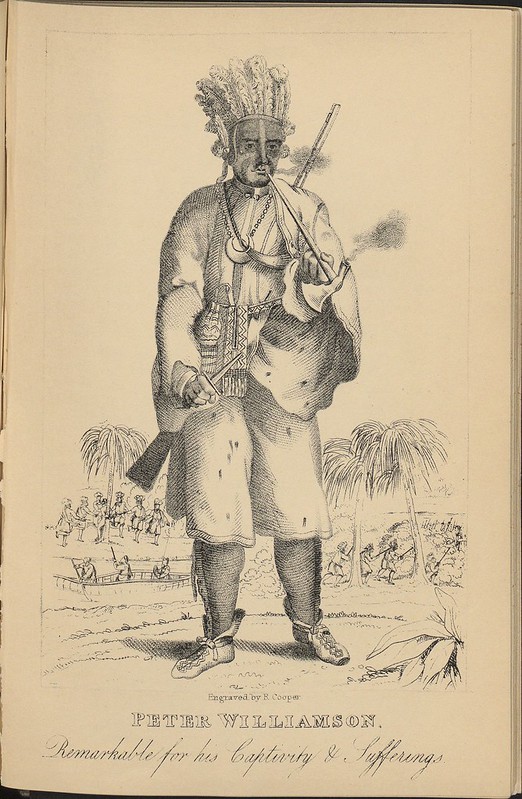
Peter Williamson - Remarkable for his Captivity & Sufferings
"I was sent to live with an aunt at Aberdeen, where, at eight years of age, playing on the quay, with others of my companions, being of a robust constitution, I was taken notice of by two fellows belonging to a vessel in the harbour, employed by some of the worthy merchants of the town, in that villainous practice called kidnapping — that is, stealing young children from their parents, and selling them as slaves in the plantations. [..]
[pages & pages documenting his sad US life with ill treatment and misfortunes]
[Williamson] published a narrative of his sufferings, but neither the strange vicissitudes of his own fortune, chequered with uncommon calamities, nor the good intention of his narrative, could protect him from the resentment of some merchants of Aberdeen, where he went in quest of his relations; because, in the introduction to his narratives, he had noticed the manner in which he had been illegally hurried away on board ship, and sold for a slave. For that publication he was imprisoned, 350 copies of his book (the only means he had of obtaining his sustenance), were taken from him, and his enlargement only granted him on his signing a paper, disclaiming two or three pages of his book. However, as he soon after found a few of his relatives, he got affidavits proving he was the person taken away as mentioned in the narrative. The precise period of Williamson's death is uncertain. He exhibited himself in London in 1760 and 1761, habited in the dress of a Delaware North American Indian, as represented in the accompanying portrait."
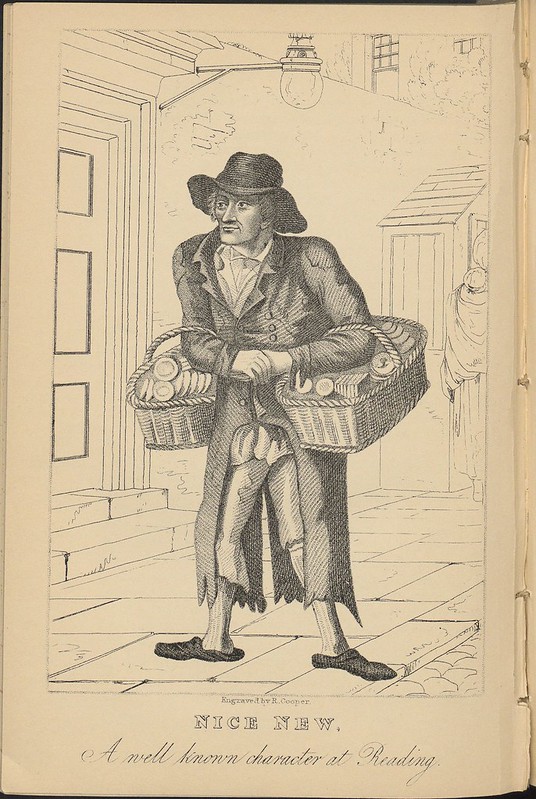
Nice New - A Well Known Character at Reading
"This curious harmless fellow, in the early part of the nineteenth century, formed one of the principal living curiosities of Beading, in Berkshire, where he resided many years.
Although not having much beauty to boast of, he yet had numerous followers and admirers, for the articles he vended rendered him an object of peculiar attraction to the rising
generation; his unwieldy baskets on each side being always stored with cakes and other delicacies for children. His cry also of *Nice new! Nice new!* with sometimes the alluring addition of *Here they be, two sizes bigger than last week*, delivered in a most melancholy, sepulchral tone, gained him much celebrity.
His dress, like his person, was singularly remarkable; and his baskets were so large, that they used to engage the whole of the foot-path, to the annoyance of the other passengers, but this inconvenience the good inhabitants kindly submitted to, as it was known that by his industry he made a small provision for some female relations: indeed, in order to render them some comfort, this poor fellow nearly starved himself. On Sunday he filled the important station of organ-blower at a dissenting chapel. On one occasion, happening to fall asleep during the sermon, which he did not very well comprehend, and dreaming he was travelling the streets, he all at once broke out in his usual tone, *All hot! All hot!* to the great, surprise of the congregation."
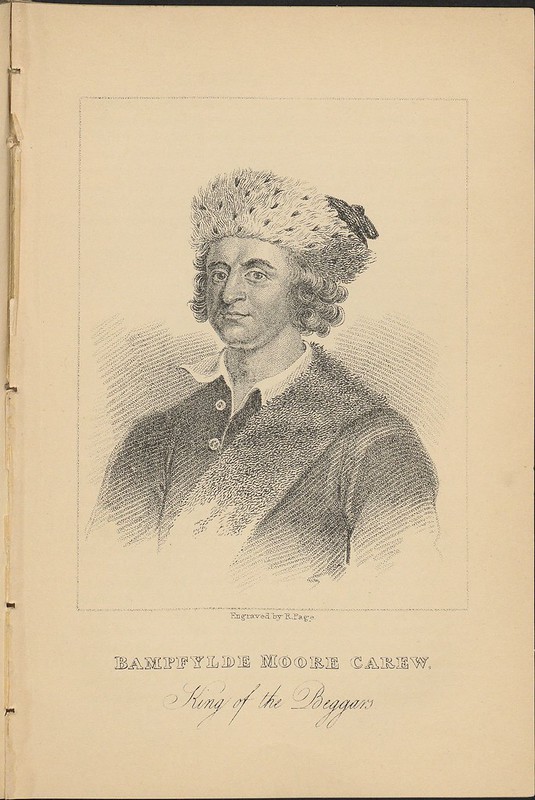
Bampfylde Moore Carew - King of the Beggars
"[O]ne of the most extraordinary characters on record, was descended from an ancient
and honourable family in the west of England [and] young Carew was soon initiated into some of the arts of the wandering tribe, and with such success, that besides several exploits in which he was a party, he himself had the dexterity to defraud a lady near Taunton of twenty guineas, under the pretext of discovering to her, by his skill in astrology, a hidden treasure. [..]
Carew so easily entered into every character, and moulded himself into so many different forms, that he gained the highest applauses from that apparently wretched community to which he belonged, and soon became the favourite of their king, who was very old."
Devon Perspectives: "His exploits were chronicled during his lifetime in a popular collection first published in 1745 entitled The Life and Adventures of Bampfylde-Moore Carew [1]. As many as 30 editions were produced over the next 50 years. Indeed, this picaresque tale was a best-seller for the next one hundred years, and was also the subject of many pamphlets." {also :: also}
{all the images have been very lightly spot-cleaned in the background}
"Printmaker James Caulfield (1764-1826) spent much of his career publishing illustrated books about 'remarkable persons'. He began his first series around 1788 and continued it sporadically from 1790 to 1795, with books on a similar theme continuing to appear in the first decades of the nineteenth century. [see here]
More than forty years after his death, this collection of biographies (produced in collaboration with Henry Wilson (fl. 1820-30)) was republished in 1869. The edition's introduction explains that the renewed interest in these characters comes from the fact that 'we have nearly lost all, and are daily losing what little remains of, our individuality'. The vignettes, accompanied by engravings of each individual, describe a wide-ranging group - from the man who died aged 152 to a 'remarkable glutton' to a woman who lived on the smell of flowers - their only common factor being that they were in some way 'wonderful'." [source]
- 'The Book of Wonderful Characters..' 1869 by H Wilson & J Caulfield is online at Harvard University Library's website.
- VIA (and very much worth seeing) the Characters, Curiosities, and Eccentrics entry from earlier this year at Harvard's blog on digital preservation: The Shelf.
- The Internet Archive hosts Cornell University's copy of 'The Book of Wonderful Characters..' in multiple formats.
- Forteana has a good post (and bibliography) on magazines of 'wonder' - Wonderful, Terrific and Eccentric Magazines :
"The Mirror – though I didn't know it at the time – was a late example of a genre of periodical that was popular at the time: what one might call, for convenience, the 'wonderful magazines'. These publications specialised in marvels, everything from extraordinary adventures (such things happened quite a lot back then) to human prodigies and strange events."
- Villanova University has the 4-volume set of Caulfield's seminal 'Remarkable Persons' which was featured on BibliOdyssey a few years ago. - I haven't checked to see the difference between the present book and the Caulfield original. 'Remarkable Persons' featured about four times as many illustrations (actual engravings; including some by George Cruikshank) and I presume - without knowing for sure - that the illustrations here are based on those late 18th/early 19th century versions. At least Wilson cites Caulfield front and centre in the title. At any rate, none of the images above have been posted here previously.
- Sweeps, nomads, quacks and crawlers: The exotic down and outs of Victorian London captured on camera in the 1870s [Daily Mail].
- 'Bright Particular Stars: A Gallery of Glorious British Eccentrics' 2011 by David McVie [review | review].
- David McVie's Top-10 eccentrics in literature.
- 'The Book of Wonderful Characters..' at Amazon.
- By coincidence, a book on abnormalities (many of the photographs are of physical defects so be aware; but there are plenty of mere eccentrics too, and it's a bit more tastefully presented than many freakshow publications [of which I'm not really a big fan]) was uploaded in the last day or two: 'Abnormitäten' 1900 by Hermann-Waldemar Otto at MDZ. (click Miniaturansicht for thumbs)
The complete list of characters illustrated in The book of wonderful characters :memoirs and anecdotes of remarkable and eccentric persons in all ages and countries :-
1. Francis Battalia, the stone-eater; 2. Miss Whitehead, the bank nun; 3. Daniel Dancer, the remarkable miser; 4. Chevalier Desseasau, the vain dwarf; 5. Matthew Lovat, who crucified himself; 6. Baron D'Aguilar, of Starvation Farm; 7. Old Books, of Ripon in Yorkshire; 8. Wybrand Lolkes, the Dutch dwarf; 9. Jacob Hall, the rope-dancer; 10. Henry Constantine Jennings, the remarkable virtuoso; 11. Henry Lemoine, an eccentric bookseller; 12. Matthew Buchinger, the Little Man of Nuremburg; 13. Henry Jenkins, the modern Methusaleh; 14. Bertholde, prime minister to Alboinus; 15. Lord Rokeby, of singular eccentricity; 16. Foster Powell, the astonishing pedestrian; 17. Joseph Boruwlaski, the Polish dwarf; 18. Ann Moore, the fasting woman; 19. Floram Marchand, the great water-spouter; 20. Jane Lewson, an eccentric old lady; 21. Peter the Wild Boy, of the woods of Hamelin; 22. William Stevenson, a notorious beggar; 23. John Broughton, a notorious pugilist; 24. Joseph Clark, the posture-maker; 25. Thomas Wood, the abstemious miller; 26. Nathaniel Bentley, the well-known 'Dirty Dick'; 27. Jeffrey Dunstan, Mayor of Garrat; 28. Henry Dimsdale, Mayor of Garrat; 29. George Morland, a celebrated painter; 30. Joanna Southcott, an extraordinary fanatic; 31. Thomas Laugher, commonly called 'Old Tommy'; 32. Margaret McAvoy, the blind girl; 33. Bampfylde Moore Carew, King of the Beggars; 34. Thomas Cooke, the notorious Islington miser; 35. Eve Fleigen, who lived on the smell of flowers; 36. Mary Anne Talbot, the female sailor; 37. Renwick Williams, commonly called the Monster; 38. Jenny Darney, a character in Cumberland; 39. Samuel Terry, the Botany Bay Rothschild; 40. Daniel Lambert, of surprising corpulency; 41. Thomas Britton, the musical small coal-man; 42. Elizabeth Woodcock, who was buried in snow nearly eight days; 43. John Elwes, the remarkable miser; 44. Jeffery Hudson, dwarf to Charles I; 45. Nice New, a well-known character at Reading; 46. John Valerius, born without arms; 47. Elizabeth Brownrigg, executed for cruelty and murder; 48. John Smith, better known by the name of Buckhorse; 49. Thomas Hills Everitt, the enormous baby; 50. Elias Hoyle, of Sowerby, Yorkshire; 51. Joseph Capper, the enemy of flies; 52. Margaret Finch, Queen of the Gipsies; 53. Miss Hawtin, born without arms; 54. Charles Domery, the remarkable glutton; 55. Thomas Parr, who died at the age of 152 years; 56. Thomas Hudson, remarkable for his misfortunes; 57. Claude Ambroise Seurat, the living skeleton; 58. George Romondo, an eccentric mimic; 59. Francis Trovillou, the horned man; 60. Samuel McDonald, commonly called 'Big Sam'; 61. Miss Harvey, the beautiful albiness; 62. Sam House, the patriotic public; 63. Barbara Urslerin, the hairy-faced woman; 64. Mary East, alias James How; 65. Daniel Cuerton, and his astonishing feats; 66. Jemmy Gordon, an eccentric character of Cambridge; 67. The Chevalier D'Eon, who passed as a woman; 68. Peter Williamson, remarkable for his captivity and sufferings; 69. Madam Teresia, the Corsican fairy.



















2 comments :
A source, I believe, for Ralph Steadman's "Tales of the Weirrd".
http://www.ralphsteadmanshop.com/ralph-steadman-shop/product.asp?prod_urn=110
Undoubtedly. I think Steadman has a complete set of all Victorian comics/caricatures from which he's sought inspiration.
Post a Comment
Comments are all moderated so don't waste your time spamming: they will never show up.
If you include ANY links that aren't pertinent to the blog post or discussion they will be deleted and a rash will break out in your underwear.
Also: please play the ball and not the person.
Note: only a member of this blog may post a comment.